Birdfinding.info ⇒ A form of Western Spindalis that is uncommon in its tiny range. It can usually be found along the Woodland Trail at Botanic Park, the Mastic Trail, and North Side by listening for its thin, high-pitched calls. In 2004, Hurricane Ivan dramatically reduced the population, and its recovery has been gradual.
“Grand Cayman Spindalis”
Spindalis zena salvini
Endemic to Grand Cayman, where it is uncommon and local in dry woodlands on the eastern side of the island.
Identification
Male is unique in its range, with its striking black-and-white head pattern, olive back, and yellow-orange nape, rump, and breast.

“Grand Cayman Spindalis,” S. z. salvini, male. (Queen Elizabeth II Botanic Park, Grand Cayman; December 11, 2007.) © Steve Metz
Most resembles the closely related “Cuban Spindalis,” the male “Grand Cayman” has more of a “rainbow” pattern on its nape and rump, with multicolored gradations from olive to yellow to burnt-orange.
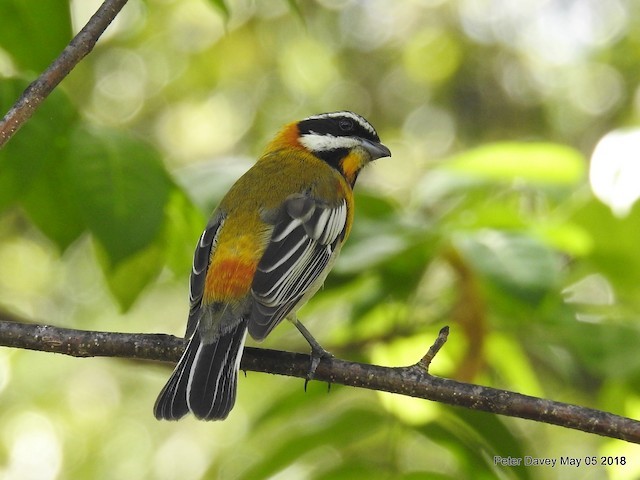
“Grand Cayman Spindalis,” S. z. salvini, male—note the “rainbow” pattern on its nape and rump. (Arlington Estate, Grand Cayman; May 5, 2018.) © Peter Davey
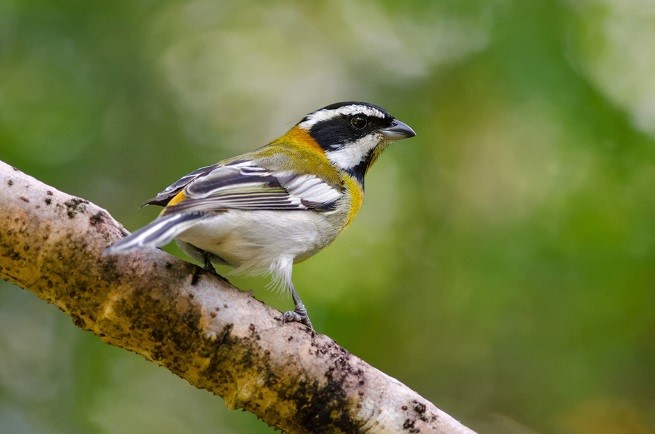
“Grand Cayman Spindalis,” S. z. salvini, male—appearing mostly gray and white from this perspective. (Grand Cayman; January 22, 2013.) © Raybel

“Grand Cayman Spindalis,” S. z. salvini, male. (Canaan Land Road, Grand Cayman; October 14, 2017.) © Denny Swaby
In a frontal view, the male “Grand Cayman’s” bib is darker than “Cuban’s”: burnt-orange overall, but dark-brown or even blackish in the center, contrasting with its paler yellow throat.
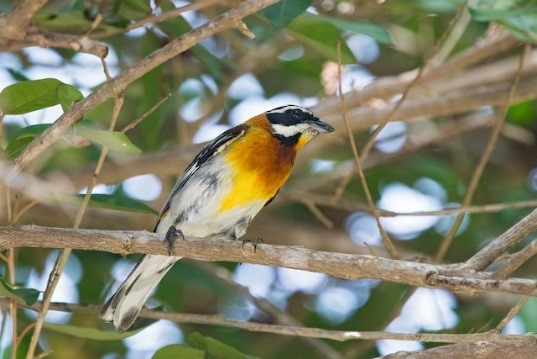
“Grand Cayman Spindalis,” S. z. salvini, male. (Queen Elizabeth II Botanic Park, Grand Cayman; July 22, 2018.) © Graham Gerdeman

“Grand Cayman Spindalis,” S. z. salvini, male. (Queen Elizabeth II Botanic Park, Grand Cayman; March 12, 2017.) © Ceri James

“Grand Cayman Spindalis,” S. z. salvini, male—note the contrast between its dark bib and pale throat. (Queen Elizabeth II Botanic Park, Grand Cayman; May 5, 2018.) © Denny Swaby
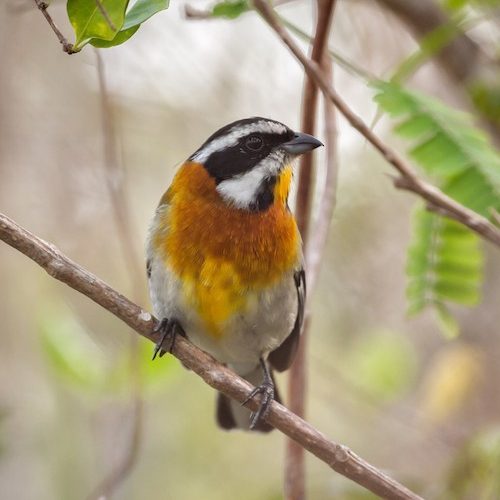
“Grand Cayman Spindalis,” S. z. salvini, male—somewhat atypical in its lack of notable contrast between bib and throat color. (North Side, Grand Cayman; February 25, 2009.) © Jim Hoover
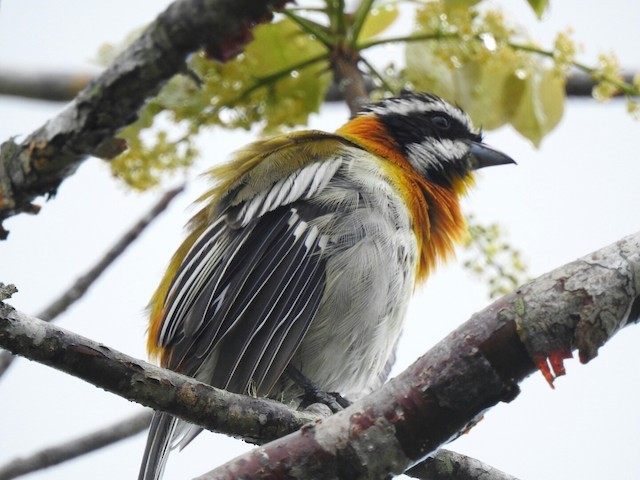
“Grand Cayman Spindalis,” S. z. salvini, male—puffed-out to dry its feathers, at dawn or after rain. (Queen Elizabeth II Botanic Park, Grand Cayman; April 30, 2017.) Anonymous eBirder
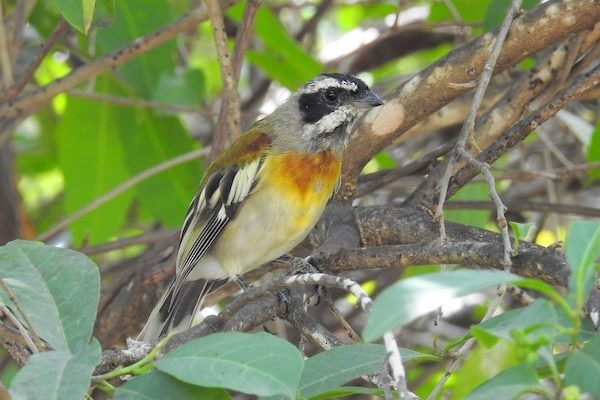
“Grand Cayman Spindalis,” S. z. salvini, immature male molting into adult plumage. (Canaan Land Road, Grand Cayman; September 22, 2016.) © Peter Davey
Female and immature “Grand Cayman” are extremely similar to “Cuban Spindalis”: drab, muted olive-gray overall with a vague representation of the male’s pattern.
Female “Cuban” shows a somewhat stronger version of this pattern, with more contrast between pale and dark tones. The contrasts are most pronounced on the female “Cuban’s” wings—less noticeable on “Grand Cayman.”
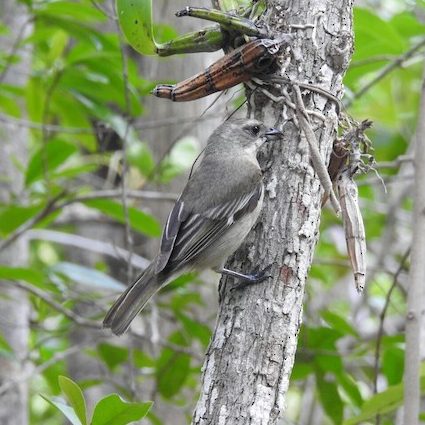
“Grand Cayman Spindalis,” S. z. salvini, female or immature. (Queen Elizabeth II Botanic Park, Grand Cayman; April 15, 2017.) Anonymous eBirder

“Grand Cayman Spindalis,” S. z. salvini, female or immature. (Queen Elizabeth II Botanic Park, Grand Cayman; April 4, 2012.) © Karl Overman
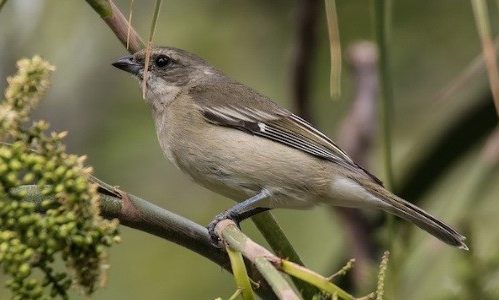
“Grand Cayman Spindalis,” S. z. salvini, female or immature. (Queen Elizabeth II Botanic Park, Grand Cayman; February 17, 2018.) © Denny Swaby
Notes
Monotypic form, one of five potentially distinct forms of Western Spindalis.
Distinguishable from other forms of Western Spindalis based on voice and coloration. “Cuban Spindalis” is clearly a close relative, and it is possible that these two forms would be best regarded as a single species separate from the other forms of Western Spindalis.
All spindalises were formerly considered to be a single species, the Stripe-headed Tanager, S. zena.
References
eBird. 2018. eBird: An online database of bird distribution and abundance. Cornell Lab of Ornithology, Ithaca, N.Y. http://www.ebird.org. (Accessed December 8, 2018.)
Hilty, S. 2018. Western Spindalis (Spindalis zena). In Handbook of the Birds of the World Alive (J. del Hoyo, A. Elliott, J. Sargatal, D.A. Christie, and E. de Juana, eds.). Lynx Edicions, Barcelona. https://www.hbw.com/node/61832. (Accessed December 5, 2018.)
Raffaele, H., J. Wiley, O. Garrido, A. Keith, and J. Raffaele. 1998. A Guide to the Birds of the West Indies. Princeton University Press, Princeton, N.J.
